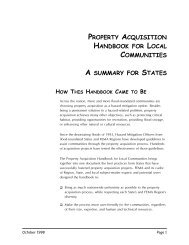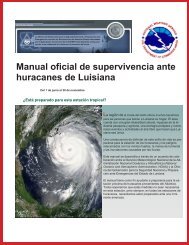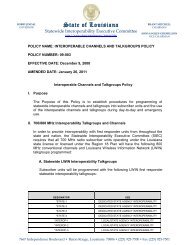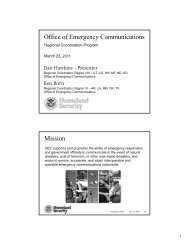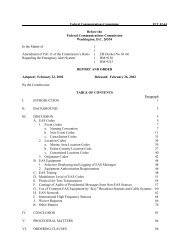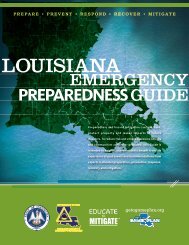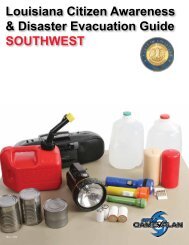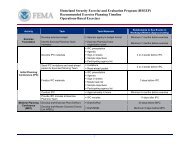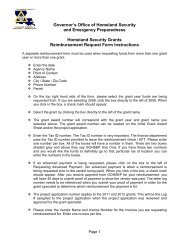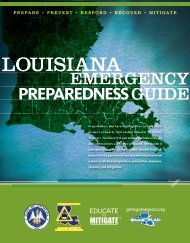Louisiana State Critical Infrastructure Protection Program (CIPP)
Louisiana State Critical Infrastructure Protection Program (CIPP)
Louisiana State Critical Infrastructure Protection Program (CIPP)
Create successful ePaper yourself
Turn your PDF publications into a flip-book with our unique Google optimized e-Paper software.
Governor’s Office of<br />
Homeland Security & Emergency Preparedness<br />
<strong>Louisiana</strong> <strong>State</strong> <strong>Critical</strong> <strong>Infrastructure</strong><br />
<strong>Protection</strong> <strong>Program</strong> (<strong>CIPP</strong>)<br />
Building a Partnership for a<br />
Better and Safer <strong>Louisiana</strong><br />
2010
Mission of Homeland Security<br />
FEDERAL - We will lead the unified national effort to<br />
secure America. We will prevent and deter terrorist<br />
attacks and protect against and respond to threats and<br />
hazards to the Nation. We will secure our national<br />
borders while welcoming lawful immigrants, visitors,<br />
and trade.
Mission of Homeland Security<br />
STATE – To lead <strong>Louisiana</strong> to prepare for, prevent,<br />
respond to and recover from, all natural and manmade<br />
emergencies and disasters.
Homeland Security Branch<br />
HSA<br />
Deputy Director<br />
of HLS<br />
Chief of Staff<br />
HLS Branch<br />
MGR<br />
Intel Officer<br />
IP Spec<br />
Intel Officer<br />
IP Spec<br />
IP Spec
Position Descriptions<br />
<strong>Infrastructure</strong> <strong>Protection</strong> Specialist<br />
• Performs highly complex tasks<br />
directing the development and<br />
implementation of the <strong>State</strong>’s <strong>Critical</strong><br />
<strong>Infrastructure</strong> <strong>Program</strong> in accordance<br />
with the National <strong>Infrastructure</strong><br />
<strong>Protection</strong> Plan (NIPP)<br />
• Direct interface with Facility Security<br />
Officers (FSOs) representing all 18<br />
CI/KR sectors<br />
• Serves HSA as conduit to pass local<br />
level CIK/KR data up to DHS, which<br />
drives HLS funding for state<br />
CI/KR<br />
Automated <strong>Critical</strong><br />
<strong>Infrastructure</strong> Asset<br />
Management System<br />
ACAMS
Intelligence Officer<br />
Position Descriptions<br />
• Position supports GOHSEP in an all-hazards manner<br />
by passing information to “need to know” recipients as it<br />
develops in real-time<br />
• Serves as a liaison with the <strong>State</strong> Fusion Center (LA-<br />
SAFE) working on multiple source areas and projects<br />
under broad management<br />
• Facilitates coordination and synchronization between<br />
the LA-SAFE and GOHSEP<br />
• Serves as <strong>State</strong> Security Officer<br />
• Manages security clearances for state & locals
National <strong>Infrastructure</strong> <strong>Protection</strong> Plan<br />
(NIPP)<br />
• The National <strong>Infrastructure</strong> <strong>Protection</strong> Plan (NIPP) provides<br />
the coordinated approach that is used to establish national<br />
priorities, goals, and requirements for CIKR protection …
National Security Strategy – May 2010<br />
• …Working with the private sector and government partners<br />
at all levels will develop an effective, holistic, critical<br />
infrastructure protection and resiliency plan that centers on<br />
investments in business, technology, civil society,<br />
government, and education.
HSPD-7<br />
…Federal departments and agencies will identify, prioritize, and<br />
coordinate the protection of critical infrastructure and key<br />
resources in order to prevent, deter, and mitigate the effects of<br />
deliberate efforts to destroy, incapacitate, or exploit them.<br />
…Federal departments and agencies will work with <strong>State</strong> and<br />
local governments and the private sector to accomplish this<br />
objective.
HSPD - 7<br />
In accordance with guidance provided by the Secretary, Sector-<br />
Specific Agencies shall:<br />
• collaborate with all relevant Federal departments and agencies,<br />
<strong>State</strong> and local governments, and the private sector, including with<br />
key persons and entities in their infrastructure sector;<br />
• conduct or facilitate vulnerability assessments of the sector; and<br />
• encourage risk management strategies to protect against and<br />
mitigate the effects of attacks against critical infrastructure and key<br />
resources.
Responsibilities of HLS Branch<br />
<strong>State</strong> <strong>Critical</strong> <strong>Infrastructure</strong> <strong>Protection</strong> Plan (<strong>CIPP</strong>)<br />
Fusion Center Liaison – Information Flow<br />
ACAMS Database Administration<br />
Federal DHS CI/KR Data Call<br />
Federal DHS Threat Data Call<br />
Federal DHS Significant Events Data Call<br />
<strong>State</strong> PCII <strong>Program</strong> Accreditation – Monitoring Visits<br />
Homeland Security Plan Writing and Coordination<br />
Buffer Zone <strong>Protection</strong> Plans<br />
Intelligence Support to <strong>CIPP</strong>
Additional Responsibilities of HLS Branch<br />
Private Sector Information Sharing and Outreach<br />
Support Federal DHS Assessments<br />
Site Assistance Visits (SVA) with DHS Protective Security<br />
Advisors (PSAs)<br />
Buffer Zone <strong>Protection</strong> <strong>Program</strong><br />
Regional Resiliency Assessment <strong>Program</strong> (RRAP)
<strong>Critical</strong> <strong>Infrastructure</strong> <strong>Protection</strong> <strong>Program</strong><br />
(<strong>CIPP</strong>)<br />
• Vision – A safe, secure, and resilient critical infrastructure<br />
based on, and sustained through, strong public and private<br />
partnerships.<br />
• Mission – Lead the state’s effort to mitigate terrorism risk to<br />
strengthen the protection of, and enhance the resilience of<br />
the <strong>State</strong>’s critical infrastructure.
18 <strong>Critical</strong> <strong>Infrastructure</strong><br />
& Key Resource Sectors<br />
• Agriculture and Food<br />
• Banking and Finance<br />
• Chemical and Hazardous<br />
Materials<br />
• Defense Industrial Base<br />
• Energy<br />
• Emergency Services<br />
• Information Technology<br />
• Telecommunications<br />
• Postal and Shipping<br />
• Healthcare and Public Health<br />
• Transportation<br />
• Water<br />
• National Monuments and Icons<br />
• Commercial Assets<br />
• Government Facilities<br />
• Dams<br />
• Nuclear Facilities<br />
• <strong>Critical</strong> Manufacturing (New)
<strong>CIPP</strong> 4 Phase Plan<br />
The <strong>State</strong> <strong>Critical</strong> <strong>Infrastructure</strong> <strong>Protection</strong> Plan<br />
• 4 Phases<br />
• Identify Assets, Systems, & Networks<br />
• Assess Risks<br />
• Prioritize<br />
• Implement <strong>Program</strong>s to Mitigate – Measure Effectiveness<br />
• Currently in Phase 1
Phase 1 – Identify Assets, Systems, & Networks<br />
• ACAMS database building<br />
• Engaging in and fostering public/private partnerships<br />
• Publish the Draft <strong>State</strong> Criteria<br />
• Building up the ACAMS User Base by getting ACAMS users<br />
identified and certified<br />
• Asking Current ACAMS users to continue to populate the<br />
ACAMS database<br />
• Meeting with local OHSEPs to review CIKR list for annual<br />
DHS CIKR data call
Constellation/Automated <strong>Critical</strong><br />
Asset Management System<br />
(C/ACAMS)
What is C/ACAMS<br />
<br />
<br />
<br />
C/ACAMS is a secure, Web-based information services portal used to support<br />
infrastructure protection efforts at the state and local level<br />
• Provides access to a comprehensive set of tools and resources to develop<br />
and implement CIP programs<br />
• Focuses on pre-incident prevention and protection but also assists in postincident<br />
response<br />
C/ACAMS leverages the close relationship between local law enforcement, first<br />
responders and asset owner/operators<br />
• CIKR owners/operators are a key partner in planning and use of C/ACAMS<br />
• C/ACAMS success depends on Public/Private Partnerships (P3)<br />
Allows DHS to augment CIKR data collection via local law enforcement and<br />
emergency management personnel across the nation<br />
• <strong>State</strong>, local personnel interact daily with CIKR owners and operators to<br />
maintain detailed, accurate infrastructure data<br />
• C/ACAMS enables the effective inventory and management of thousands of<br />
assets within state and local jurisdictional areas
What is in C/ACAMS<br />
The Main Sections of ACAMS<br />
• INV (Inventory Screen)<br />
• AMQ (Asset Manager Questionnaire)<br />
• BZP (Buffer Zone Plan)<br />
• IAV (Initial Asset Visit)<br />
• Reports/Mapping (Set of standard and custom reports w/Maps)<br />
• Admin (Administration for Groups, Users and Assets)<br />
• Searching (The ability to do advance searching across all data)<br />
• Resources (Set of document, templates and other information)<br />
• Total Assets 7,245 (December 2010)
Why Web Based<br />
Accessibility<br />
• From anywhere there is an internet connection, including wireless<br />
• Remote data entry (input) and data viewing (output)<br />
Information Sharing of <strong>Critical</strong> Asset Data<br />
• Multiple users can access a specific site’s information simultaneously<br />
Data Storage in a Centralized Location<br />
• Facilitates updates without overwriting<br />
• Off-Site storage and back-ups<br />
• Maintained by DHS
Accessing the System<br />
Roles (User types and Associated Privileges)<br />
• System Administrator (complete read & write privileges)<br />
• Supervisor (limited read & write privileges)<br />
• Analyst (read only)<br />
• Assessor/User (Can enter data and submit for approval to<br />
Supervisor)<br />
• Asset Manager (Can only access their own asset/AMQ screen<br />
only)<br />
Security Levels (Tiered Access)
Tiered Access in C/ACAMS
How does C/ACAMS benefit you<br />
C/ACAMS has been developed as a scalable tool to fit the specific<br />
needs of each jurisdiction at the state and local level<br />
• C/ACAMS is scalable and exportable to fit the specific needs of<br />
the user community and recognizes resource limitations<br />
C/ACAMS provides the framework for the development of<br />
comprehensive <strong>Critical</strong> <strong>Infrastructure</strong> <strong>Protection</strong> (CIP) <strong>Program</strong><br />
• DHS provides C/ACAMS at no cost to the state and local<br />
community to support infrastructure protection efforts
How does C/ACAMS benefit you<br />
C/ACAMS was developed in alignment with national-level guidance<br />
to ensure state and local compliance with this guidance<br />
• National Strategy for Homeland Security<br />
• The National <strong>Infrastructure</strong> <strong>Protection</strong> Plan (NIPP)<br />
• Homeland Security Presidential Directives (HSPD) 7 & 8
C/ACAMS<br />
ACAMS Questions
Draft Criteria - <strong>State</strong><br />
<br />
CI/KR assets will be placed on the <strong>State</strong> CI/KR List if they meet Federal<br />
DHS Criteria and/or one of the following state criteria:<br />
• Loss of facility would cause severe prolonged disruption to the<br />
state’s ability to prepare for, protect against, mitigate, or respond to<br />
all hazards.<br />
• Facility has agents reportable under CFATS, or TCI, is required to<br />
file a Response Management Plan (RMP) or is designated a<br />
Biosafety Level 3 or 4.<br />
• Loss of facility would result in mass casualties.<br />
• Loss of facility would result in prolonged mass evacuations of<br />
populated places.<br />
• Loss of facility would result in job loss in excess of 500.<br />
• Loss of facility would result in an economic impact greater than<br />
$500 million.<br />
• Facility provides a utility service to major metropolitan areas or other<br />
CI/KR assets that meet the state criteria.
Phase 2 – Assess Risks<br />
• Conduct Assessments - MSHARP+V assessments of all tier<br />
one identified assets – conducted by local HLS with<br />
assistance from GOHSEP<br />
• Mission, Symbolism, History, Accessibility, Recognizable,<br />
Recoverability, Population, Proximity, + Vulnerability<br />
(MSHAP+V)<br />
• CARVER assessments on each critical node within the<br />
tier one asset
Phase 3 - Prioritize<br />
• Assist visits to locals to build tier lists for their area of<br />
operation<br />
• Identification of local “Tier One” Facilities<br />
• Assistance in completion of Buffer Zone <strong>Protection</strong> Plans
Buffer Zone <strong>Protection</strong> Plan (BZPP)<br />
A DHS Report Designed to:<br />
• Identify specific threats and <strong>Critical</strong> <strong>Infrastructure</strong>/Key Resources<br />
vulnerabilities within the “buffer zone”<br />
• Identify potential preventive and protective measures that can be<br />
taken by a responsible jurisdiction to devalue, deter, detect and<br />
defend an asset
VRPP Report<br />
Vulnerability Reduction Purchasing Plan (VRPP):<br />
• Assists with the implementation of preventive and protective<br />
measures identified through the BZP<br />
• Provides form for planning and equipment requests for<br />
responsible jurisdictions to implement preventive and protective<br />
measures around CI/KR
Phase 4 – Implement <strong>Program</strong>s to Mitigate –<br />
Measure Effectiveness<br />
• Creation and Publication of a <strong>State</strong> <strong>Critical</strong> <strong>Infrastructure</strong> List<br />
(SCIL) based on the assessments and scores assigned by<br />
local HLS<br />
• Submission of Buffer Zone <strong>Protection</strong> Plans<br />
• Submission of Vulnerability Reduction Purchasing Plans<br />
(VRPPs)<br />
• Site survey sent to BZPP sites – follow up on vulnerabilities<br />
addressed via BZPP funds
<strong>CIPP</strong> Success<br />
A successful <strong>State</strong> <strong>CIPP</strong> will result in – A safer, more resilient, critical<br />
infrastructure base in <strong>Louisiana</strong>.<br />
A <strong>State</strong> <strong>CIPP</strong> program that satisfies HSA requirements listed in<br />
the National <strong>Infrastructure</strong> <strong>Protection</strong> <strong>Program</strong>, HSPD-7, and<br />
The National Security Strategy – May 2010<br />
A <strong>State</strong> List of prioritized critical infrastructure that identifies<br />
significant critical infrastructure and key resources and ranks<br />
them according to their Risk Score<br />
A Risk Score that can be part of the Grant Allocation Equation<br />
A tangible assessment to give to the local Homeland Security<br />
managers to support their decisions to mitigate potential risks<br />
within their area of responsibility<br />
Satisfy EMAP Accreditation Requirements for <strong>State</strong> CI/KR<br />
Assessments
Risk Score Report<br />
<strong>CIPP</strong> – Results<br />
• Shows us how we compare to the rest of the country.
2010 DATA CALLS<br />
35
Jill M. Babin<br />
Questions<br />
Homeland Security Branch Manager<br />
Governor's Office of Homeland Security<br />
& Emergency Preparedness<br />
Work: (225) 358-5300<br />
E-mail: jill.babin@la.gov<br />
HSDN: jill.m.babin.sle@dhs.sgov.gov




